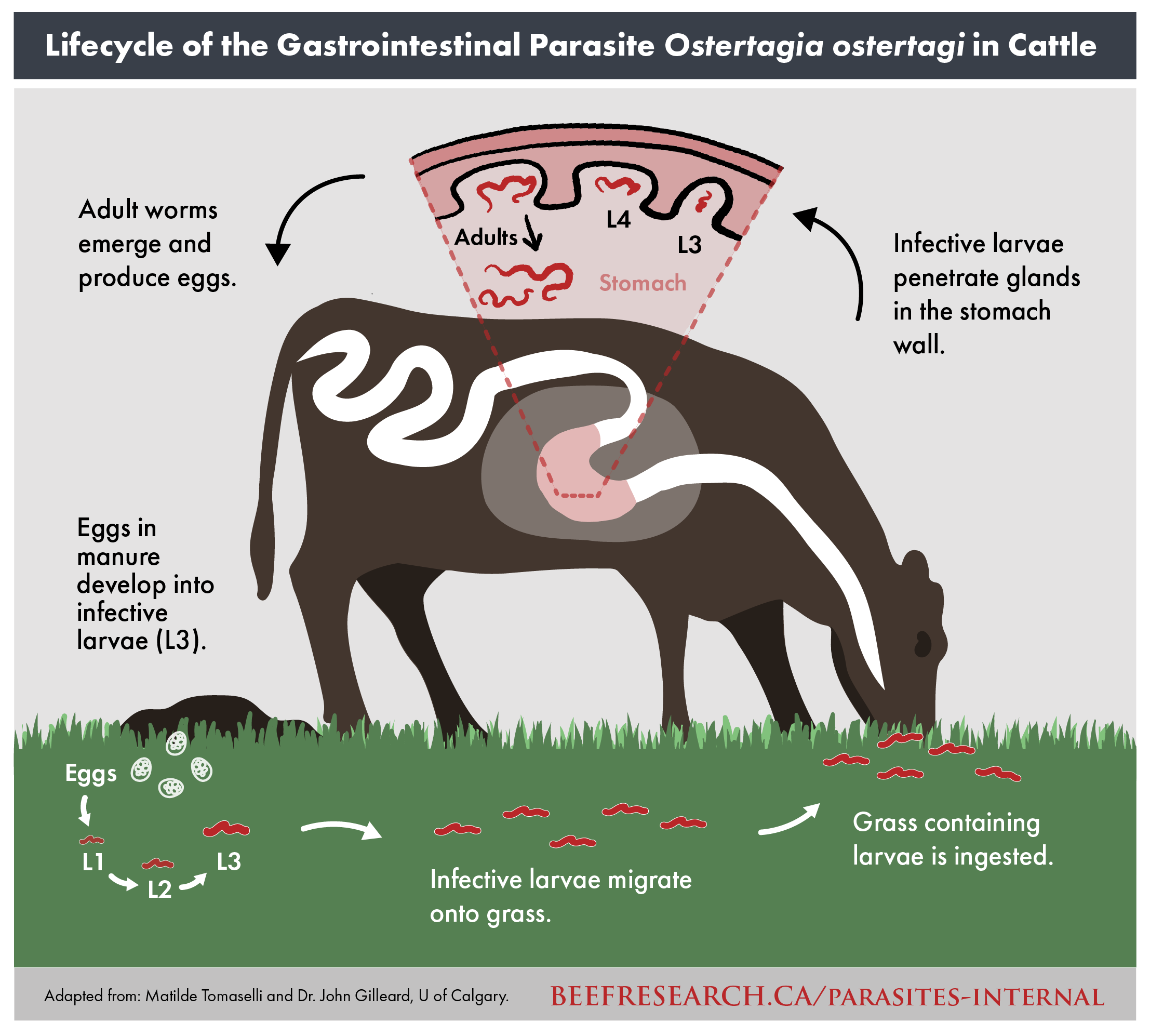Internal Parasites Affecting Beef Cattle
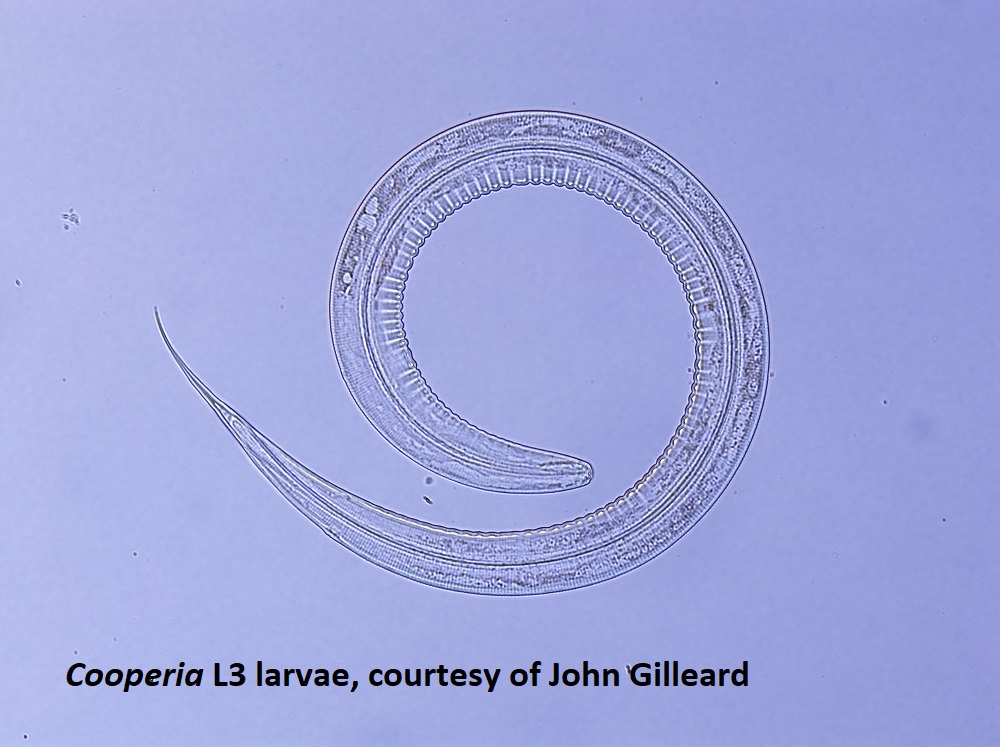
Parasites, both internal and external, can affect production and cause disease in Canadian beef cattle. Effective parasite control in beef cattle is an important part of maintaining health, welfare and production and different parasites require specific control measures.
Understanding internal parasites and monitoring their activity will help producers implement effective management and control strategies that mitigate the impact on animal health, welfare, productivity and profitability.
Click to visit the BCRC’s external parasite page.
| Key Points |
|---|
| To effectively control internal parasites in beef cattle, producers first need to know which parasites they are dealing with. |
| Roundworms are the most common and economically important group of internal parasites in beef cattle. |
| Roundworm impacts can include reduced appetite and grazing behaviour, depressed weight gains, poor feed efficiency and diarrhea in calves and yearlings, and reduced milk production and reproductive inefficiency in cows. |
| Adult roundworms live inside the gastrointestinal tract of adult cattle, shedding eggs in cattle Adult roundworms live inside the gastrointestinal tract of adult cattle and shed their eggs in the feces. Eggs develop into larvae which live on pasture grass and are consumed by grazing cattle, causing the cycle to repeat itself. |
| Cattle under the age of two typically have the highest worm burdens and are most impacted, however internal roundworms are found in adult cattle as well. |
| Proper pasture management, such as avoiding overgrazing, harrowing only when it is hot and dry, and avoiding use of a pasture in the fall then the following spring, can help reduce worm burdens. Be aware that pastures last grazed by yearling cattle can affect young cattle grazing the following year. |
| Monitor parasite loads by collecting manure samples so your veterinarian can conduct parasite egg counts (fecal egg count, or FEC). |
| To minimize drug resistance in parasites, it is important to use the correct product, at the correct time, on the correct class of cattle, at the correct dosage, and then check for effectiveness. |
| Drug resistance , particularly to ivermectin and related products, now occurs in several roundworm species in Canada. |
Common parasites in Canada
Internal parasites, such as roundworms and coccidia, live inside the gastro-intestinal tract whereas external parasites, such as lice and flies live on, or around, the animal. When planning parasite control measures, discuss both internal and external parasites with your veterinarian to ensure an overall integrated parasite control program is in place.
Before developing a parasite control program it is important to understand which parasites affect your herd and to what extent.
Table 1: Common Parasites Affecting Beef Cattle in Canada
| Type | Internal or External | Impact on Animal |
|---|---|---|
| Roundworms: Brown stomach worm (Ostertagia ostertagi), instestinal worms (Cooperia oncophora and punctata, Nematodirus helvetianus) | Internal | Roundworms are the most common class of internal parasites in beef cattle and impacts can be insidious. They cause depressed weight gains, poor feed efficiency, diarrhea in calves and reduced milk production and reproductive inefficiency in cows. |
| Lungworms (Dictyocaulus viviparous). Sporadic disease outbreaks | Internal | Lungworms in upper airways of respiratory system cause nasal discharge, coughing and difficult breathing. It is a sporadic disease in Canada but can be severe affecting both calves and adult cattle. |
| Fluke (flatworm) (Fascioloides magna) | Internal | Fascioloides magna has a regional distribution (eg. Foothills of Rockies, Great Lakes). It is carried by elk/deer and transmitted in wet boggy areas via semi-aquatic snails. It causes liver condemnation and impact on production poorly defined. |
|
Tapeworms (Monezia benedeni) |
Internal |
Tapeworms are several metres long and are common. Segments can often be seen in manure but are not considered harmful. |
| Coccidia (Eimeria bovis, Eimeria zuernii and other Eimeria spp.) |
Internal |
Coccidiosis is caused by single celled parasites that invade and destroy cells lining the intestine. It is very common in Canada, causing acute dysentery and diarrhea, neurological signs, chronic diarrhea and reduced growth. Disease most commonly occurs in 1-6 month old calves. |
| Lice (Damalinia bovis, Linognathus vituli, Haematopinus eurysternus, Solenopotescapillatus) |
External |
There are two types of lice, biting and sucking lice. Numbers increase with cooler temperatures reaching maximum levels in late winter. Lice cause coat discolouration and hair loss, and sometimes anemia and production loss. |
| Stable Flies (Stomoxys calcitrans) |
External |
Typically affect confined livestock, but can also occur on pasture. Bites are painful and often bleed. Pain and decreased production due to reduced grazing/feeding, and animal fatigue from attempts to dislodge insects. |
|
Horn flies (Haematobia irritans) |
External |
Horn flies congregate around and on cattle at pasture all summer. They bite and suck blood, affecting livestock behaviour, causing reduced performance and reduced milk production. |
| Cattle grubs (Hypoderma bovis, H. lineatum)
|
Internal & External | Ivermectin has reduced the prevalence of cattle grubs in Canada to very low levels but they are still present in localized areas. Adult female flies lay eggs in the hair of the animal which hatch into grubs and migrate deep into the tissues where a painful warble develops that causes pain to animals and holes in the tissue. |
| Cryptosporidium (cryptosporidium spp.) | Internal | Cryptosporidium, often termed crypto, is a parasite that causes gastrointestinal illness. The primary sign is mild to moderate diarrhea that lasts several days. Typically impacts young calves from 1 to 4 weeks of age. |
| Giardia (Giardia spp.) | Internal | Caused by Giardia spp., Giardiaosis is an intestinal infection impacting young calves <6 months of age. Signs include abdominal discomfort and diarrhea. |
The following video explains the different types of internal parasites that affect beef cattle in Canada (16:58), the economic impact they can have (27:39), drug resistant parasites (36:54), and control strategies (40:06).
Video: Managing Internal Parasites in Beef Cattle
Internal roundworms
A common myth is that it is too cold in Canada for roundworm parasites to be a problem, but that is not the case.
Internal roundworms are extremely common but are less obvious than external parasites (e.g., lice and flies) which are often clearly visible. Cattle affected by roundworms can have depressed weight gains, poor feed efficiency, diarrhea in calves, and reduced milk production and reproductive inefficiency in cows. Parasite species also vary by region.

Canadian beef producers are often more concerned with controlling visible external parasites. A common misconception is that it is too cold in Canada for roundworm parasites to be a problem. This is not true. Several species of roundworm parasites (including Ostertagia ostertagi, Cooperia oncophora, and Nematodirus battus) are well-adapted to cold weather are widespread in Canadian beef cattle, and can impact production. The most damaging of these is Ostertagia ostertagi. Although cattle younger than two years of age typically have the highest worm burdens and are most impacted by internal roundworms, even adult cattle carry worms and contribute to pasture contamination. Other species (such as Cooperia punctata and Haemonchus placei) are also present in Canada and occasionally cause problems but are more common in warmer regions such as the southern US
The lifecycle of other internal roundworm parasites such as Cooperia oncophora, Cooperia puntata, Nematodirus helvetiatianus, are very similar. The key to parasite transmission and control for these roundworm species is pasture contamination. Adult roundworms living in the gastro-intestinal tract produce eggs which pass out in the feces and then develop to infective L3 larvae in the fecal pat. This can occur in as little as 7 days under optimal conditions but can take several weeks in cooler weather. The L3s then migrate into the soil and onto the grass where they are ingested by cattle during grazing. Transmission only occurs on pasture because L3s do not survive in indoor or feedlot pen environments. Although the development from egg to L3 only occurs in the spring, summer, and early fall, infective L3 larvae can survive over the winter in the soil and be a source of infection to cattle grazing the following spring. Parasites also survive over the winter inside the animal host as adult worms and inhibited larvae. Pasture contamination builds up over the grazing season to maximum levels in the late summer and early fall.
Parasite egg counts in cattle in Canada tend to be in the range of 1- 50 eggs per gram (epg) of feces but in situations of heavy pasture contamination counts as high as 200-300 epg can occur in individual animals. If you consider a typical beef cow might produce 30kg of feces each day, a single cow with an egg count of 10 epg would shed ~300,000 eggs onto the pasture each day!
Infective L3 larvae can survive the winter on pasture to varying degrees, even in Canada, and adult worms and inhibited larvae can survive during the winter inside the host. The relative importance and success of roundworm “overwintering” strategies will vary depending on the temperature, moisture and snow cover in a particular year. During the spring, summer and fall, numbers of infective larvae build up on pastures. Warm and wet summers, and contaminated pastures can lead to higher worm burdens in beef cattle.
Economic impact of internal roundworms
The largest academic assessment of production impacts of internal roundworm parasites occurred in North America in 2007. The study evaluated the economic impact of parasite control, growth promotants, sub-therapeutic antibiotics, and ionophores. Of all these technologies, deworming had the biggest positive impact in cow-calf (23% higher weaning rates due to improved pregnancy rates and calf survival), stockers (reduced the price to break even by $20.77 per head) and the second highest benefit after growth promoter implants at the feedlot (5.6% higher average daily gain and 3.9% improvement in feed:gain).
It is important to note that there is no one size fits all scenario for parasite control.
Studies from the northern United States showed that production gains occurred when parasite burdens were eliminated using a long-acting anthelmintic known as eprinomectin, a slow-release injectable formulation (Kunkle 2013). In the US study, untreated cattle had fecal egg counts ranging from 2-84 eggs/gram. Once treated, cattle had effectively zero egg counts. This resulted in production gains averaging between 0.16 to 0.54lbs/day (14 to 65 lbs over 120 days of grazing). Similar egg counts within this range are commonly seen in Canadian beef cattle with the major species present being roundworm species like Osteragia ostertagi, Cooperia oncophora and Nematodirus helvetianus. This suggests that good roundworm control should produce significant production gains in Canadian beef cattle as well. This is supported by a recent study showing similar gains for stocker cattle in Western Canada3.
It is important to note that there is no one size fits all scenario for control. Herds will vary in the impacts of roundworm depending on geographical location in Canaa (including regions within a province), rainfall and temperature during the grazing season, stoning densities and grazing patterns.
Effectiveness of parasite control

There is a limited ability to accurately assess worm burdens in live animals and there are practical challenges to implementing recommended control measures at optimal times. In addition, the longstanding use of anthelmintic (dewormer) products, particularly ivermectin, has led to parasites becoming increasingly resistant to these products which limits their effectiveness. We know that pour-on dewormer treatments used in Canadian beef cattle are often only partially effective at clearing worm burdens, as demonstrated in the image below. This may be due to the products not being properly applied as well as the presence of drug-resistant parasites. Recent collaborative work between the Western College of Veterinary Medicine and the University of Calgary Faculty of Veterinary Medicine has confirmed the presence of ivermectin resistant Cooperia oncophora, Cooperia punctata and Haemonchus placei in Western Canadian Beef Cattle4.
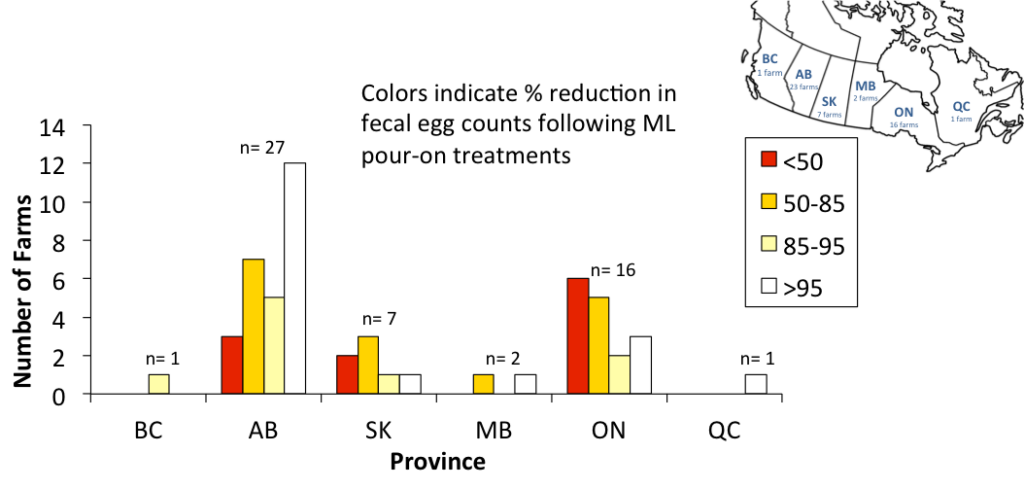
The chart shows the percentage reduction in roundworm egg counts following an ivermectin or doramectin pour-on treatment in 54 beef herds across Canada. Fecal samples were taken from 20 calves in the herd before pour-on treatment and 2 weeks after pour-on treatment and fecal egg counts were conducted. The different coloured bars indicate the numbers of herds in each of the following categories; less than 50%, 50-85%, 85-95% and greater than 95% reduction in fecal egg counts following treatment. From this study, we know that internal roundworm parasites are not well controlled in Canadian beef cattle and most of the parasite burdens detected were enough to likely cause production losses.
Drug-resistant parasites are an inevitable consequence of using dewormers. The more we use these products, the more resistance develops over time. Consequently, it is important that dewormers are used in a way that maximize benefits but avoids overuse to maintain their longer-term efficacy.
Prevention and control measures
A good internal roundworm parasite control program should maximize production gains, minimize disease risk but avoid haphazard and unnecessary dewormer use. The aim is to use the correct product at the correct time on the animals that need it most. The issues and practicalities of roundworm parasite control differs significantly between cow-calf, stocker and feedlot cattle. There is also a large amount of variation between different herds and different years for the same herd. These differences are due to geographical location, weather patterns (precipitation and temperature), grazing patterns and management strategies of each individual herd.
The aim should be to minimize the use of dewormers whilst maximizing production and health benefits. Overuse of dewormers selects for resistant parasites and also has negative impacts on the biodiversity of important invertebrate fauna on pastures and beyond.
Recommended practices are outlined below however producers should consult with their veterinarians to develop a parasite control program appropriate for their specific herd and environment.
Grazing management
- Avoid overstocking and overgrazing. Heavily stocked pastures lead to increased pasture contamination with infective parasite larvae. Overgrazing increases the number of parasite larvae ingested since cattle graze closer to fecal pats and closer to ground where the numbers of parasite larvae are highest.
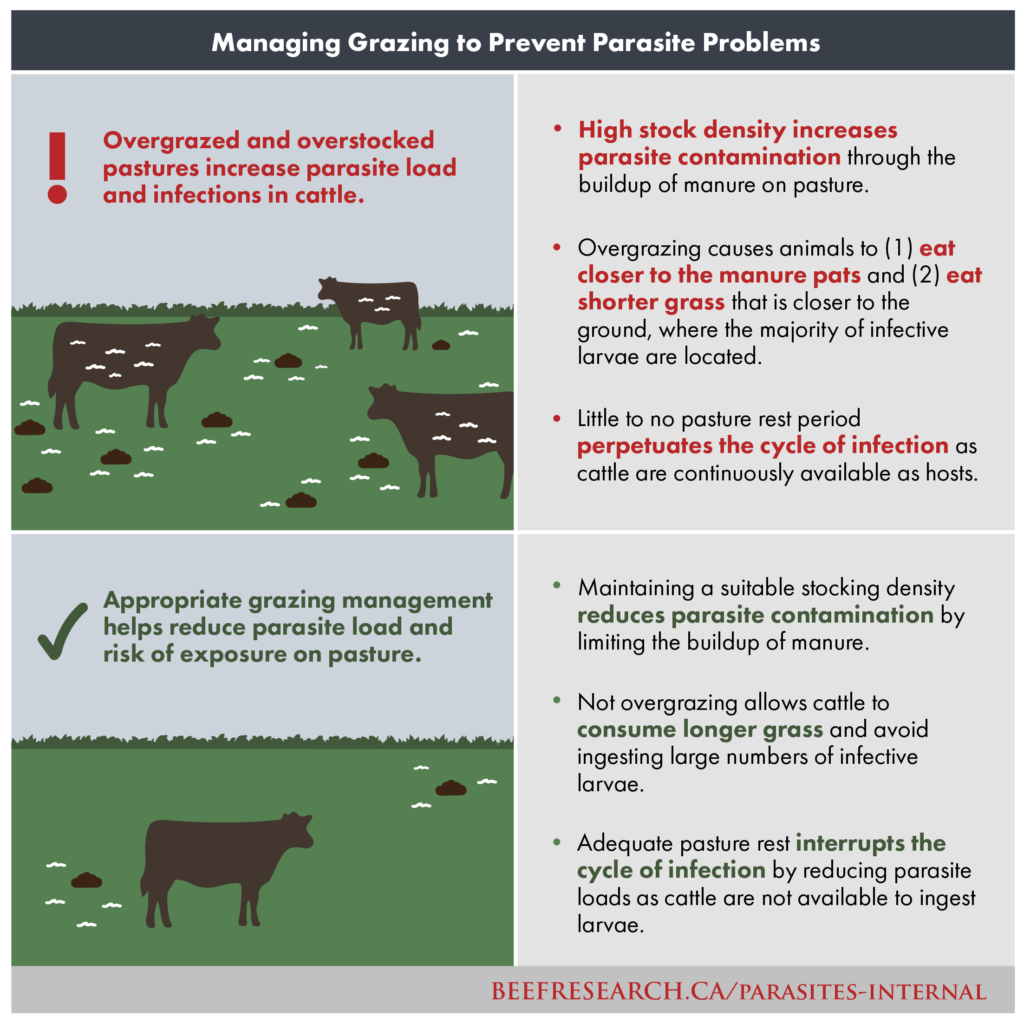
- When possible, avoid grazing the same pasture in fall and the next spring. Infective parasite larvae from eggs deposited in manure in fall may survive the winter on the pasture and be a source of contamination for cows and calves grazing in the spring.
- When possible, harrow pastures only when it’s hot and dry. Harrowing under other conditions will increase the potential exposure of cattle as infective larvae are scattered from fecal pats across the area.
- Consider parasite control when planning rotational grazing strategies. For example, if a twice over or rotational grazing system is implemented, be aware that pastures previously grazed by yearling or stocker cattle may be heavily contaminated with infective parasite larvae and so be a risk to younger cattle.
Monitor parasite burdens
Conduct fecal egg counts on your herd to assess internal roundworm parasite loads and determine which parasites you need to target.
Parasite burdens can vary significantly between herds and between years. Therefore, it is important to monitor parasite burdens to assess the need for and effectiveness of treatment.
Consult your veterinarian, who can advise on sampling strategy. Collect fresh manure samples, which can be from the pasture, and submit them to your veterinarian who can perform fecal egg counts and interpret your results. Typically, fecal samples from 20 cows in the spring and from 20 calves in the fall will provide useful information on parasite burdens in the herd and the effectiveness of current control programs. Individual samples can sometimes be pooled in the laboratory to provide herd level assessments in a cost effective manner.
Fecal egg counts are a valuable tool but only provide an indirect measure of worm burdens and do not discriminate between the different parasite species present in the sample. Consequently, results need to be interpreted in the context of your grazing management, production practices, and parasite control regimes.
Over 300 insect species are found in cow dung on Canadian pastures; mating, eating dung, laying eggs, eating each other – all while providing valuable ecosystem services.
The Cow Patty Critters guide is a dung detective’s handbook for studying cow dung communities on pastures across Canada. The second part of the Cow Patty Critters guide provides tools and instructions on how to identify dung insects and other critters.
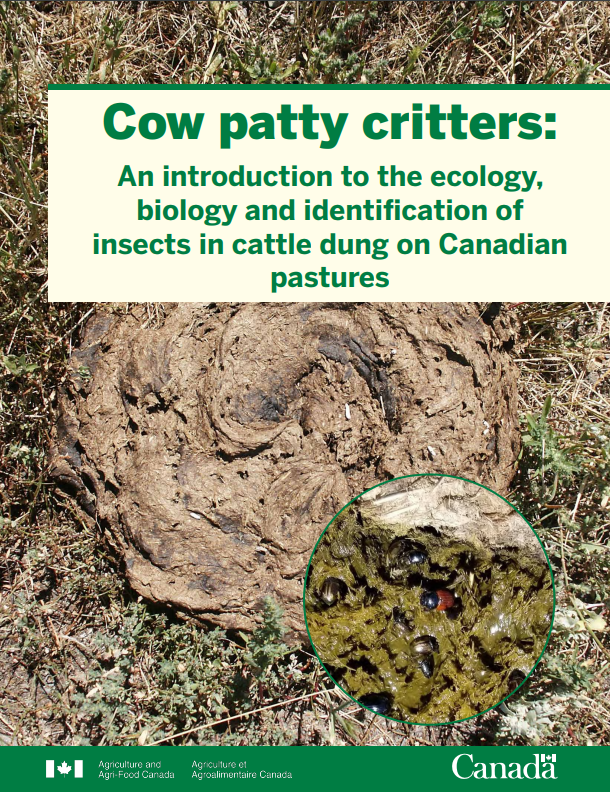
Use dewormers effectively and responsibly

Choose the correct dewormer. Common internal and external parasite controls are highlighted in Table 2 below. Each dewormer has its own strengths and weaknesses and varies in effectiveness against specific parasite species. For example, macrocyclic lactone dewormers (e.g., ivermectin and other ‘mectin’ products) are becoming less effective against Cooperia and Haemonchus adult parasites and also are less effective than they were against inhibited ostertagia larvae inside the cattle due to resistance. There is at present less resistance to Fenbendazole or albendazole in cattle parasites in Canada although these intrinsically have limited efficacy against inhibited larvae of Ostertagia.
External parasite control also needs to be considered. For example, ivermectin targets many external parasites whereas fenbendazole does not. However, it is important to think of ectoparasite and internal parasite control separately and choose the correct product for each based on a risk assessment.
- Use the correct product
- Apply to correct class of animal
- Apply at the correct time
- Use the correct dose
- Check for efficacy
Dewormers come in several formulations that differ in convenience and effectiveness including injectables, oral pastes or drenches, in-feed pellets or minerals or topical pour-on products. It is important that the correct formulation is chosen for the specific application and this will differ between herds and at different times of year.
- Administer the dewormer at the correct time. Dewormers should be used strategically to minimize pasture contamination and prevent the build-up of roundworms in the cattle during the grazing season. Treatments are often given when it is convenient – when cattle are being processed – rather than at the best time for control. Consequently, in many herds, roundworm control depends on pour-on treatments applied in the fall, partly because of the need to also control external parasites. However, spring treatments can sometimes provide added benefits leading to lower roundworm burdens in the fall. Producers should consult their veterinarians to plan a strategic worm control program that balances best practice with the practical realities of herd management.
In many herds, roundworm control depends on pour-on treatments applied in the fall, partly because of the need to also control external parasites. However, spring treatments can sometimes provide added benefits leading to lower roundworm burdens in the fall.
- Administer the dewormer properly. Weigh cattle to ensure you administer the correct dose for the animals you are treating. Underdosing is ineffective and leads to resistant parasites. Use the proper route of delivery for the specific product (oral, injectable, fed, topical). Follow veterinary advice and label instructions for administration, storage and withdrawal times prior to slaughter. Adhere to recommended practices in Canada’s Verified Beef Production Plus on-farm food safety program. Properly dispose of expired product, empty containers and used needles.
- Check the effectiveness of dewormer treatments. Do not assume a dewormer treatment has been effective. It is increasingly important to check the effectiveness of treatments to prevent parasite resistance. This can be done by taking fresh fecal samples and performing fecal egg counts approximately two weeks after deworming. Collecting and analyzing 20 samples from cows and 20 samples from calves will provide a good estimate of the treatment efficacy for the group. Pooling of individual samples at the laboratory is sometimes approrpiate so consult your veterinarian about the details of such sampling.
Biosecurity
New cattle introduced onto your farm are a source of parasites that will contaminate your pastures. Treating such cattle with a combination of dewormers from the two major drug classes (e.g., ivermectin plus fenbendazole) will minimize the risk of bringing resistant parasites into your farm. Consult your veterinarian to discuss your parasite biosecurity program.
Progressive ideas
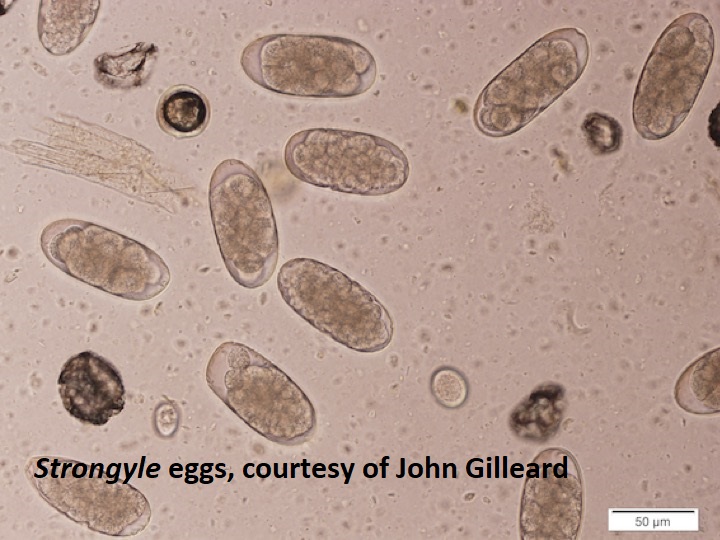
Leave a small proportion of the herd untreated. In most well managed herds, the 10-20% of cattle that are in the best condition actually don’t benefit from dewormer treatments. They only carry low worm burdens and their productivity won’t suffer if they are not treated. The key benefit of this approach is that the eggs shed by the untreated animals will “dilute” the population of resistant parasites on the pasture. This can greatly reduce the rate of which drug resistant parasites are selected for, helping to maintain the effectiveness of the few dewormer products that are available.
Use a combination of two dewormers. Dosing cattle with two dewormers of different classes at the same time both maximizes the effectiveness of treatment and slows the development of resistance. It is important not to mix products before dosing but to administer each sequentially, using the correct administration route and following the label instructions. Consult your veterinarian to discuss using dewormer combinations as part of your herd health and parasite control programs.
Table 2: Common Parasite Control Products for Beef Cattle in Canada
| Common Parasite Control Products | Parasites Controlled | Mode of Administration | Example of Brand Name Products Registered for Use in Canada |
|---|---|---|---|
| External Parasites | |||
| Carbaryl | Horn flies, lice, winter ticks | Body spray | Sevin |
| Cyfluthrin | Horn flies, lice | Topical pour-on | Cylence |
| Lambda-cyhalothrin | Face flies, horn flies, Rocky Mountain wood ticks | Ear-tag (flies), pour-on (ticks) | Saber |
| Permethrin | Horn flies, lice, Rocky Mountain wood ticks | Topical pour-on | Boss |
| Pyrethrin | Horn flies, house flies, stable flies, mosquitos | Body spray | Numerous |
| Pyrethroid | Lice, face flies, stable flies, horn flies, horse flies, black flies, deer flies, ticks | Topical pour-on | Clean-Up II |
| Internal and External Parasites | |||
| Doramectin2,3 | Internal roundworms, lungworms, eye worms, cattle grubs, lice and mites | Topical pour-on, injectable | Dectomax |
| Eprinomectin2,3 | Internal round worms, lungworms, grubs, lice and mites | Injectable (sub-cutaneous slow-release formulation) Pour-on |
LongRange, Eprinex |
| Ivermectin2,3 | Internal roundworms, lungworms, cattle grubs, lice and mites | Topical pour-on, injectable | Bimectin, Ivomec, Noromectin |
| Internal Parasites | |||
| Albendazole1 | Internal roundworms, tape worms, lung worms | Oral drench | Valbazen |
| Fenbendazole1 | Internal Roundworms | Feed, Mineral, pellets Oral Drench |
Safeguard Safeguard, Pancur |
| Decoquinate | Internal Coccidia | Feed | Deccox |
| Lasalocid | Internal Coccidia | Feed | Bovatec, Avatec |
| Monensin | Internal Coccidia | Feed | Rumensin, Coban, Monensin |
| Toltrazuril | Internal Coccidia | Oral drench | Baycox |
*Every effort has been made to ensure the accuracy of the information above. However, it remains the responsibility of the readers to familiarize themselves with the product information contained on the Canada product label or package insert. Ensure label directions and veterinarian instructions are followed when using any veterinary product.
The first five drugs on the list are dewormers with activity against internal roundworms.
1 Fenbendazole and albendazole belong to same drug class (Benzimidazoles).
2 Ivermectin, Doramectin, Moxidecitn belong to same drug class (Macrocyclic lactones).
- References
-
1 B.N. Kunkle et al. / Veterinary Parasitology 192 (2013) 332–337
2 Lawrence, J. D., and M. A. Ibarburu. 2007. “Economic Analysis of Pharmaceutical Technologies in Modern Beef Production.” Proceedings of the NCCC-134 Conference on Applied Commodity Price Analysis, Forecasting, and Market Risk Management. Chicago, IL. [https://www.agrireseau.net/bovinsboucherie/documents/confp05-07.pdf]
3 Rademacher, et al. 2018. The Bovine Practitioner, Vol. 52, No. 1
4 DeSerum, et al., 2023. International Journal of Parasitology: Drugs and Drug Resistance, 22 (2023): 27-35.
Feedback
Feedback and questions on the content of this page are welcome. Please e-mail us at info@beefresearch.ca.
Acknowledgments
Thanks to Dr. John Gilleard from the University of Calgary Faculty of Veterinary Medicine for contributing his time and expertise in writing and reviewing this page.
This content was last reviewed April 2024.
